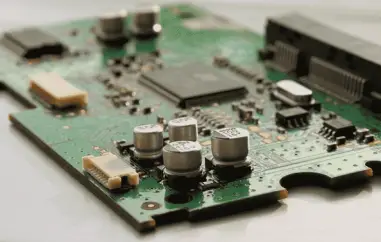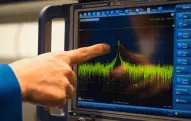Labor is German chip sector's biggest challenge
 Behind the Iron Curtain, chip development was centered in the former East German city of Dresden. Both in Dresden and the area around it, that legacy is still present. Today, more than three decades later, Saxony supplies one in three of the semiconductors produced in Europe. .
Behind the Iron Curtain, chip development was centered in the former East German city of Dresden. Both in Dresden and the area around it, that legacy is still present. Today, more than three decades later, Saxony supplies one in three of the semiconductors produced in Europe. .
Millions of dollars have been invested in the state, and Saxony, the rumored location of a future TSMC plant, is home to fabrication facilities, or "fabs," for firms like Infineon, Bosch, and Globalfoundries.
But the sector is being affected by a lack of skilled workers.
Thanks in part to nearby clusters of research institutions, semiconductor-related businesses, and technical universities, the regional chip industry in Saxony employs over 76,000 people. According to lobbyist predictions, this number will reach 100,000 by 2030.
However, neither for Germany nor for the entirety of Europe, that is insufficient. The European Union plans to increase its current semiconductor manufacturing capacity from 10% to 20% by that time. How that might happen may be revealed by looking at Dresden's efforts to develop talent and recruit skilled workers.
Sampada Godkhindi is a graduate of the Technical University of Dresden, which in 2011 introduced a master's program in nanoelectronic systems, drawing many international students and establishing a talent pipeline that goes straight to business. After working for a German automotive parts company, Godkhindi, an Indian native from Karnataka, started researching English-language masters programs in Germany, and TU Dresden consistently came out on top of her searches. She obtained a job at GlobalFoundries as an integration engineer at that company after receiving her degree because she wanted to remain in the neighborhood. In this position, she patterns electronic components onto semiconductors.
Producers have been able to "secure both experienced chip experts and young graduates and skilled laborers for our chip factories thanks to universities like TU Dresden and nearby research institutes like the Helmholtz Center and Fraunhofer Institute," semiconductor maker Robert Bosch GmbH told Bloomberg via email.
The semiconductor industry is home to a thriving ecosystem of businesses, which is supported by trade associations like Silicon Saxony. Chipmakers, academic institutions, and suppliers are all represented by this organization, which has over 450 members in the area.
Legislators want to establish similar circumstances all over Europe. The final version of the EU Chips Act, which committed 43 billion euros to boosting the bloc's semiconductor industry, was agreed upon by European negotiators in April. The EU wants to close the skills gap in microchip production in addition to providing subsidies for research and significant new fabs. Programs like the European Chips Skills 2030 Academy, which aims to train 500,000 microelectronics experts over the course of the next ten years, could be helpful.
Germany is also attempting to prevent a shortage of qualified workers. The government unveiled its education, upskilling, labor participation, workplace culture, and emigration reduction strategy in October of last year. The biggest economy in Europe is also changing its immigration policies to make it simpler for skilled workers from other countries to enter Germany.
These actions are especially necessary because, according to a study from IW Koeln, 33% of engineering supervisors and 28% of electrical engineering experts in Germany's semiconductor industry will reach retirement age within the next 10 to 12 years. Between June 2021 and June 2022, the industry in Germany as a whole reported a 62,000 employee shortage. Germans are not entering the workforce as many are getting older, so "there is still a huge need for foreign skilled labor," a spokesperson for the German Labor Ministry told Bloomberg.
In the past ten years, Dresden's foreign population has more than doubled. Sean Gallup/Getty Images is the photographer.
To the benefit of the chip manufacturing industry, Dresden has prioritized this in recent years. Infineon, which recently broke ground for a fourth fab in the city, employs people from over 50 different countries in Saxony, while GlobalFoundries has more than 40 different nationalities represented at its site in Dresden. Last year, many of the 65 students who registered for the chipmaking course at TU Dresden came from China and Iran, with Indian citizens making up 57% of the class.
The long-term effect of western nations reducing their emphasis on STEM education is part of these shifting demographics. Syed Alam, a Global High Tech Industry Lead at Accenture, stated that there were fewer electrical engineers graduating from universities.
According to Silvana Muscella, the Technical Coordinator of ALLPROS . eu, an EU project funded by the Digital Europe Programme, chipmakers in the EU also find it difficult to compete with the wages offered elsewhere in the world. Because they are unable to pay as much as an organization in Singapore, South Korea, the United States, or Canada, Muscella claimed that Europe is losing talent.
The higher salaries offered in other technical fields, some of which have the additional appeal of being less physically demanding, are making it difficult for chipmakers to compete on a larger scale. Even newly-minted electrical engineers might not be choosing the semiconductor industry as their top career choice, according to Alam. They will work in the software sector. " .
According to Frank Boesenberg of the lobbying group Silicon Saxony, businesses are focusing on the issue in addition to government-level initiatives to attract people to the industry. He expressed his desire to interact with those "who may only enter the industry in ten years or less" in an interview. "Recruiters and HR representatives talked up the field to university students at an industry open house the group hosted at the Dresden airport.
Boesenberg was also very specific about where his future coworkers would most likely be. "It will be very difficult, if not impossible, to meet all of the industry's needs from Saxony alone in the present and in the future. Therefore, immigration is necessary," he declared.
Another difficulty is persuading them to remain in Germany once they have arrived. Chipmakers are keenly aware of the need to maintain Dresden's appeal to foreigners as support for the far-right Alternative for Germany has grown in Saxony in recent years.
Programs have been started to match skilled tech workers from India with jobs in Saxony, business organizations assist newcomers in adjusting to life there, and local organizations promote community building among immigrants. Although Dresden is not as diverse as some of Germany's larger cities, the percentage of foreigners there has increased since 2014.
Godkhindi can envision staying in Dresden for a very long time after four years. Godkhindi believes Germany could do a better job of marketing itself to prospective international students as her adopted country works to expand its chip industry and draw in talent from abroad.
Germany is a very welcoming country for students, she said. "The quality of your education is very high, and your living expenses are not too high. Additionally, students in India are not well-advertised to this fact. ".
Article originally appeared in Bloomberg: https://www.bloomberg.com/news/articles/2023-07-01/the-german-chip-sector-s-next-challenge-labor









































